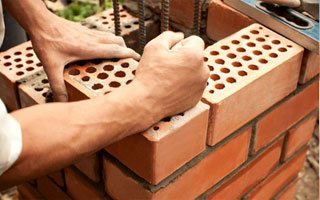Unlocking the Keys of Lasting Masonry Building Practices for Eco-Friendly Buildings
Among the myriad methods to green structure, lasting masonry building stands out as a tried and true and long lasting technique that holds a wealth of untapped potential. From the selection of products to ingenious construction techniques, the secrets to accomplishing sustainability within masonry construction are complex and fascinating.
Benefits of Sustainable Stonework Construction
Accepting lasting stonework building techniques not only lowers environmental impact yet additionally supplies long-term financial benefits to contractors and areas. By using materials like recycled blocks, blocks, and rocks, contractors can considerably reduce the carbon impact of their tasks while advertising source efficiency. Furthermore, lasting stonework construction techniques, such as appropriate insulation and thermal mass homes, can boost energy effectiveness within structures, causing reduced operational prices in time.
In addition, the sturdiness and strength of masonry structures add to long-term economic advantages. Structures created using sustainable stonework methods frequently call for less upkeep and repair, translating to cost savings for builders and building owners. The long life of masonry products likewise guarantees that frameworks continue to be stable and safe, decreasing the demand for frequent remodellings or replacements.
Eco-Friendly Masonry Products
Using eco-friendly masonry products is a crucial step towards boosting the sustainability of construction methods and minimizing environmental influence while taking full advantage of long-term financial advantages. Lasting masonry products are sourced, produced, and utilized in a manner that decreases total ecological impact. Sustainable concrete blocks integrate recycled aggregates and might include better insulation residential properties, adding to energy efficiency in structures.
In addition, all-natural products like adobe, rammed planet, and straw bales offer exceptional thermal mass buildings, decreasing the demand for home heating and cooling energy. These materials are commonly in your area available, promoting local economies and minimizing transportation-related carbon emissions. By choosing environment-friendly stonework products, construction jobs can considerably reduce their environmental impact and add to the creation of healthier, much more lasting built atmospheres.
Energy-Efficient Masonry Methods
Power performance plays an important role in improving the sustainability of stonework building and construction practices. By implementing energy-efficient masonry methods, home builders can dramatically reduce the total energy consumption of a structure, bring about lower operational expenses and a smaller sized ecological impact. One crucial energy-efficient stonework strategy is making use of thermal mass, which involves integrating thick products like concrete or block into the building's structure to absorb and store warmth. This assists manage indoor temperatures, reducing the demand for mechanical heating and cooling down systems.

Technologies in Lasting Masonry
Current advancements in sustainable stonework methods have actually produced ingenious methods that are improving the construction market. One such technology is the development of self-healing concrete, which uses bacteria embedded within the concrete to heal cracks autonomously. This innovation not only minimizes upkeep costs however likewise boosts the longevity of masonry structures, adding to their riverside auto sales sustainability.
An additional significant innovation is using recycled accumulations in stonework construction - masonry contractor. By incorporating materials such as crushed ceramic waste or recycled glass into concrete mixes, building contractors can decrease the ecological impact of construction jobs while preserving architectural honesty. This practice not just diverts waste from landfills however additionally saves natural deposits, making it an essential innovation in sustainable stonework building
Additionally, the integration of electronic layout tools, such as Building Details Modeling (BIM), is changing the method masonry structures are intended and created. their explanation BIM permits even more precise computations, minimized product waste, and enhanced power efficiency, inevitably bring about more lasting structure methods. These developments collectively indicate an appealing future for sustainable masonry construction in the era of green structures.
Future Trends in Masonry Sustainability
With the innovative strides made in lasting masonry techniques, the future trends in masonry sustainability are poised to more revolutionize the building sector. One of the essential patterns forming the future of stonework sustainability is the enhanced assimilation of technology. Advancements such as Structure Information Modeling (BIM) and online fact simulations are being used to maximize masonry building procedures, resulting in lowered product waste and enhanced energy efficiency in structures.
In addition, the development of novel lasting products is established to play a significant duty in enhancing the eco-friendliness of masonry construction. masonry contractor. Innovations like self-healing concrete, recycled aggregates, and bio-based binders are acquiring traction for their capability to decrease environmental effect while preserving structural stability

Conclusion
Finally, lasting masonry building and construction methods provide various advantages for green buildings. By making use of eco-friendly products and energy-efficient techniques, masonry can add to a more lasting constructed atmosphere. Advancements in lasting stonework are continually being created to additionally enhance the ecological link efficiency of structures. Looking towards the future, the pattern of masonry sustainability is expected to grow, leading to even more eco-friendly and energy-efficient building practices in the years to find.